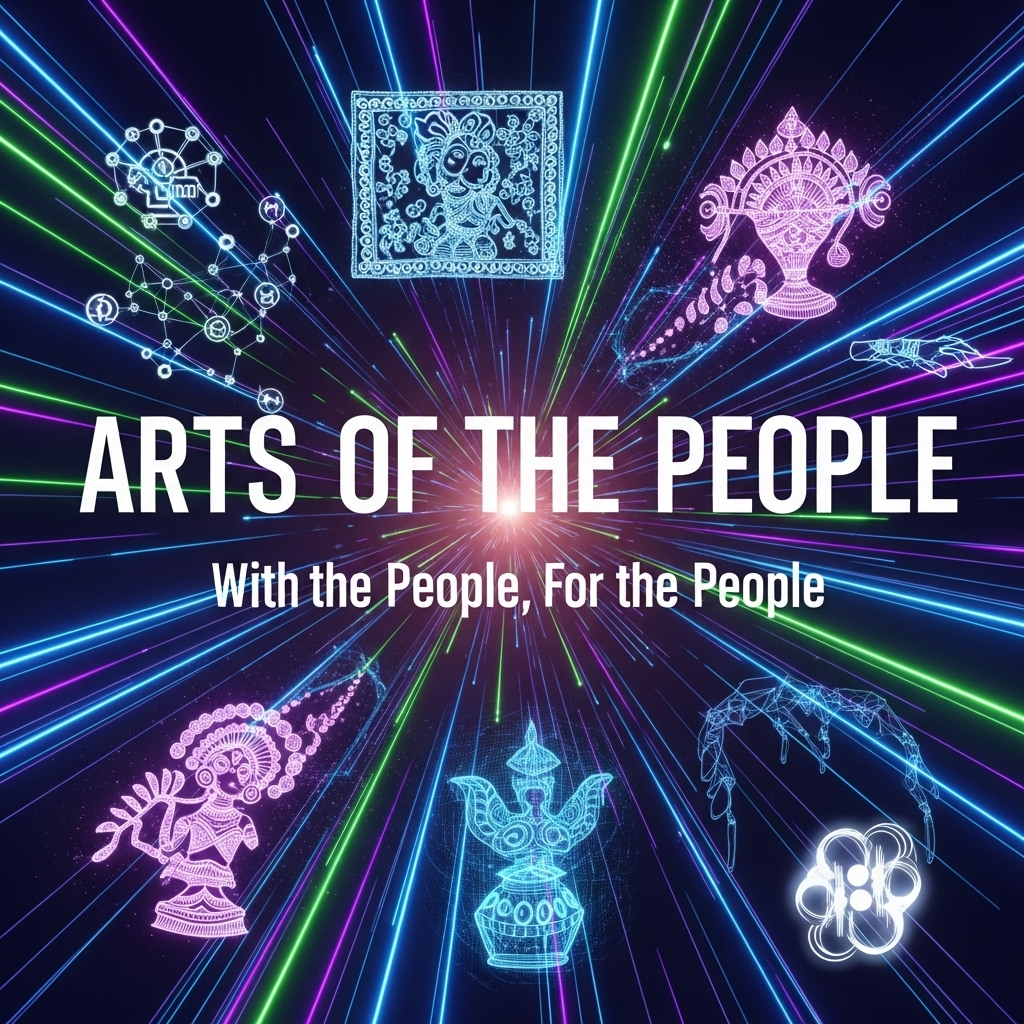Complete Solutions and Summary of Arts of the People, With the People, For the People – NCERT Class 8, Arts, Chapter 18 – Summary, Questions, Answers, Extra Questions
Detailed summary and explanation of Chapter 18 ‘Arts of the People, With the People, For the People’ with all question answers, extra questions, and solutions from NCERT Class VIII, Arts (Kriti).
Updated: 2 months ago

Arts of the People, With the People, For the People
Chapter 18: Visual Arts
Complete Study Guide with Interactive Learning
Chapter Overview
What You'll Learn
Art in Daily Life
Explore how art is integrated into everyday objects like clothes and plates.
Traditional Techniques
Learn about techniques like twisting, knotting, and weaving used in art.
Living Root Bridges
Discover the unique art of training roots in Meghalaya to form bridges.
Artist Dedication
Appreciate the hard work of artists preserving these traditions.
Historical Context
Art has been a part of human life since prehistoric times, connecting us to our ancestors through artefacts. The chapter highlights how innovations in materials and social changes influence art, with a focus on Meghalaya's living root bridges as a sustainable art practice.
Key Highlights
The chapter introduces everyday materials like thread, paper, and cloth transformed into art through dedication, with the living root bridges showcasing nature's role in artistic expression.
Comprehensive Chapter Summary
1. Introduction to Arts of the People
The chapter begins by tracing art's presence since prehistoric times, emphasizing its role in connecting humans across time through artefacts that reflect emotions and imagination.
2. Art in Everyday Life
Daily Objects
Art is evident in clothes, plates, and other daily items, showcasing creativity in routine life.
Influence of Innovation
Changes in materials and technology shape art processes, enhancing creative expressions.
Social Impact
Social values and behaviors influence artistic thoughts, reflecting cultural evolution.
3. Traditional Art Techniques
Twisting and Knotting
Techniques like twisting and knotting are used to create objects like baskets and bridges in Meghalaya.
Weaving and Knitting
Weaving and knitting produce handloom fabrics and fans, preserving traditional skills.
Crocheting
Crocheting adds to the variety of techniques used for everyday items like charpoys.
4. Living Root Bridges of Meghalaya
Nature's Art
The Indian rubber tree's roots are trained to form bridges, strengthened over time with support.
5. Artist Dedication
Preserving Traditions
Artists' patience and hard work keep art practices alive using everyday materials.
Activity 18.1
Students are encouraged to create artwork with natural fibers, connecting to nature's networks.
6. Sustainable Choices
The chapter stresses the importance of sustainable art practices, highlighting the connection between human societies and nature.
Key Concepts and Definitions
Artefact
An object carrying the voice and touch of its creator, connecting past and present.
Twisting
A technique to intertwine materials for support, used in bridge-making.
Knotting
A method to secure materials, enhancing the strength of art objects.
Weaving
A process to create fabrics and baskets using threads or fibers.
Living Root Bridges
Natural bridges formed by training tree roots in Meghalaya.
Sustainable Art
Art practices that use nature responsibly, promoting ecological balance.
Important Facts and Figures
Questions and Answers from Chapter
Short Questions
Q1. What is an artefact?
Q2. Where are living root bridges found?
Q3. What is twisting?
Q4. What is knotting?
Q5. What is weaving?
Q6. What is a living root bridge?
Q7. What materials are used in Activity 18.1?
Q8. What is crocheting?
Q9. What is knitting?
Q10. Since when has art been part of human life?
Q11. What strengthens living root bridges?
Q12. What is the purpose of Activity 18.1?
Q13. What influences art processes?
Q14. What reflects cultural evolution?
Q15. What is sustainable art?
Medium Questions
Q1. Why is art important in daily life?
Q2. How do living root bridges form?
Q3. What is the role of artists in preserving traditions?
Q4. How do innovations influence art?
Q5. What is the significance of Activity 18.1?
Q6. How do social values affect art?
Q7. What materials are used to create baskets?
Q8. Why are living root bridges sustainable?
Q9. What emotions does art trigger?
Q10. How do artists use everyday materials?
Q11. What is the connection between nature and art?
Q12. What is the purpose of knotting in art?
Q13. How long do living root bridges take to form?
Q14. What is the role of weaving in daily life?
Q15. Why is patience important in art?
Long Questions
Q1. Explain how art has been part of human life since prehistoric times.
Q2. Describe the process of creating living root bridges in Meghalaya.
Q3. Discuss the importance of traditional techniques in art.
Q4. How do innovations and social changes influence art processes?
Q5. What is the significance of Activity 18.1 in understanding art?
Q6. Explain the connection between human societies and nature in art.
Q7. How do artists' lives influence their artwork?
Q8. Discuss the role of patience and hard work in art.
Q9. How do everyday materials contribute to art practices?
Q10. What makes living root bridges a unique art form?
Q11. Explain the process of weaving in creating daily use items.
Q12. Why is sustainable art important for future generations?
Q13. How does art reflect cultural evolution?
Q14. Discuss the challenges faced by artists in preserving traditions.
Q15. How does Activity 18.1 foster an appreciation for art?
Interactive Knowledge Quiz
Test your understanding of Arts of the People
Quick Revision Notes
Art Basics
- Since prehistoric times
- Everyday objects
- Emotional connection
Techniques
- Twisting
- Weaving
- Knotting
Root Bridges
- Meghalaya
- Natural growth
- Sustainable
Artist Role
- Patience
- Preservation
- Dedication
Exam Strategy Tips
- Focus on techniques
- Understand root bridges
- Appreciate artist effort
- Study nature's role
- Practice Activity 18.1

Group Discussions
No forum posts available.
Easily Share with Your Tribe


